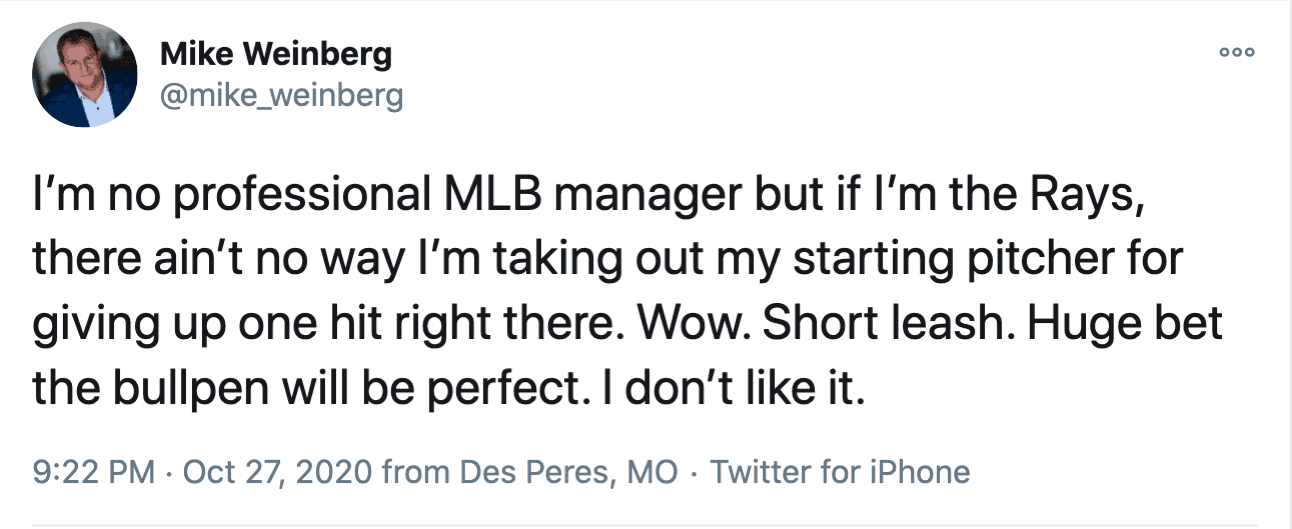Even if you’re not a baseball fan or didn’t see the final World Series game last week, there was a simple, yet colossal, lesson for anyone who manages people:
It’s important to see things (observe your people working) with your own eyes!
To the horror of baseball fans across the country, Tampa Bay Rays’ manager Kevin Cash abruptly pulled starting pitcher Blake Snell out of the game after giving up a hit in the sixth inning. Up to this point in the game, Snell was beyond dominant and hadn’t even thrown 80 pitches! He was executing a pitching masterpiece that was a sight to behold, and I was marveling at his performance, control, power, command, etc.
So shocked (and angry) to see Tampa Bay’s manager headed to the mound to replace his pitcher, I took to Twitter and instantly launched this tweet which ended up being prophetic:

And that was before hearing Joe Buck (who did an outstanding job announcing the game for Fox Sports) tell the audience that Snell had completely shut down the next three batters due up for the Dodgers who collectively had zero hits in six at-bats and struck out six times against him. Honestly, no one, and I mean no one (except the Dodgers) were happy to see this pitcher removed. It’s not an exaggeration to say that no one agreed this was the right move.
Why am I sharing this story and my frustration about this with you? Because, just like in sales, there’s been a movement in baseball recently that decisions get made by management who are far from the action sitting in their ivory towers pouring over reams of data – even Big Data. And while old-school baseball fans love to talk data and statistics, we’ve seen enough evidence to declare that baseball strategy managed exclusively by analytics has not panned out to be the great panacea it was purported to be. Said differently, just because the analysts and their super computers can produce an indigestible volume of analytics and reports doesn’t necessarily mean that’s a good thing, or that managerial decisions should be made solely by what the spreadsheets conclude.
The same is even more true regarding sales management. There are more technological tools, toys, and dashboards than we know what to do with. Many execs and sales managers have become data-obsessed living with their heads buried in CRM screens and reviewing more data than a normal brain can possibly digest. Yet, these very same sales leaders often declare that they’re too busy to work with, observe, and coach their salespeople.
The following excerpts are from the chapter in Sales Management. Simplified. titled “Playing CRM Desk Jockey Does Not Equate to Sales Leadership.”
"It’s beyond comprehension how it has become the norm today to judge a salesperson’s ability solely by overanalyzing each of his deals and what percentage of opportunities advance from stage to stage in the CRM. It’s as if we’ve decided to replace true sales experts with quantitative mutual fund managers. Just stick the manager behind a large screen with lots and lots of data under the guise that if she stares at it long enough she’ll figure out which stocks to buy. . . I mean which salespeople can sell…
Can you imagine a Major League Baseball team manager, even one known for his love of stats, probabilities, and sabermetrics, not sitting in the dugout during the game? Not watching players perform with his own eyes?... Think about the absurdity of a sports team manager sitting in his office all day (and all night) reviewing reports and data, making lineup decisions based only on what he sees on his screens and spreadsheets."
While I wrote that five years ago, it was surreal watching it play itself out on TV last week!
Of course, the Tampa Bay manager was not literally away from the team studying analytical reports during the game, but it is now widely understood that his decision (or the higher-ups’ in the executive suite decision) to prematurely take the pitcher out of the game in this situation was actually predetermined before the game even started.
The bottom-line is that an awful decision was made relying solely on data analytics. What’s most concerning is that just about every living, breathing human with eyes and ears watching or listening to that game (including players on both teams) would have made a different decision based on what they were personally observing at the time.
Various thoughts and takeaways for sales leaders:
- As important as pipeline metrics and CRM data are, how well are you supplementing that information by personally observing your team members in action?
- Working with salespeople is not an optional part of the sales manager’s job. Coaching, observing, debriefing, and challenging are must-do’s, not nice-to-do’s.
- If a sales leader is too busy to work with his/her people then something is fundamentally broken. Whether it is the company not understanding sales management priorities and diverting managers with other tasks and corporate crap, or it’s the sales managers themselves who’ve lost sight of the primary job and their role as people developers/mentors/coaches, something needs to change.
- Just because it’s labeled as research or some analyst is capable of producing a big fat report, that doesn’t mean the data is useful (or necessarily even true! See Chapter 3 in Sales Truth – “Just Because It’s Published Doesn’t Mean It’s True”)
Let’s all learn from this baseball manager’s analytics-only-driven mistake. There are times when what our gut, our eyes, or our ears are telling us is superior to what the data analysts predict or what we’re seeing on a CRM screen. I’m not suggesting we ignore the data, but we certainly should blend it with our personal observations – which, of course, requires that we actually prioritize spending time alongside our team members!



